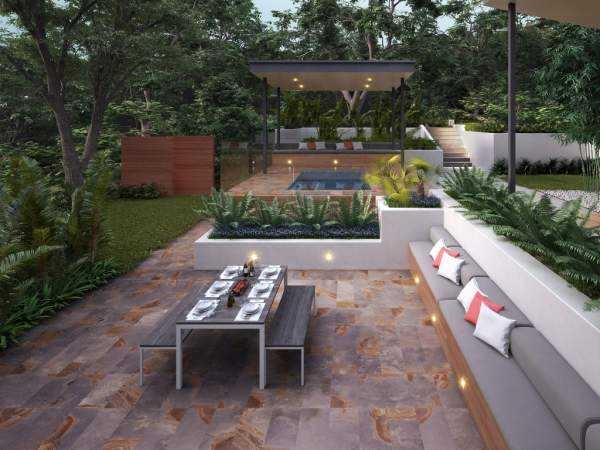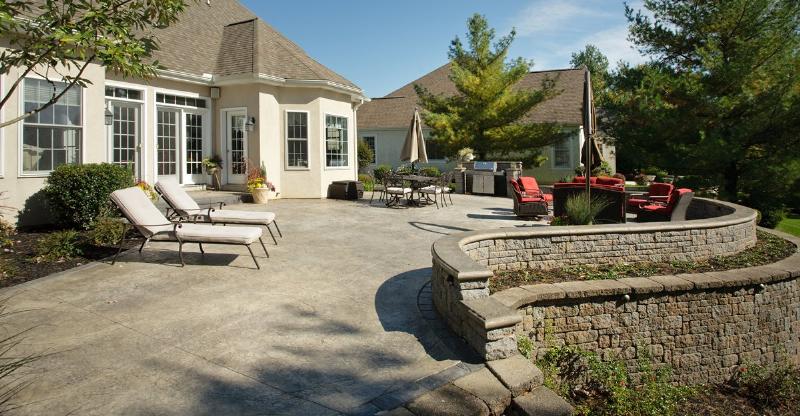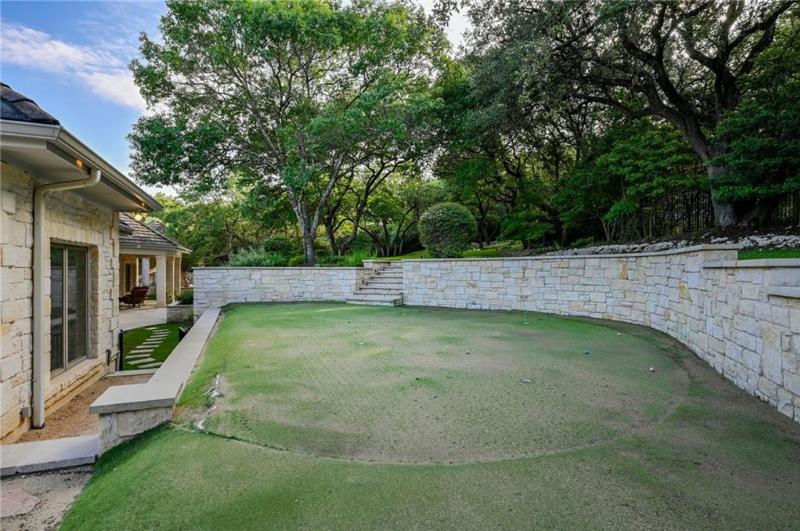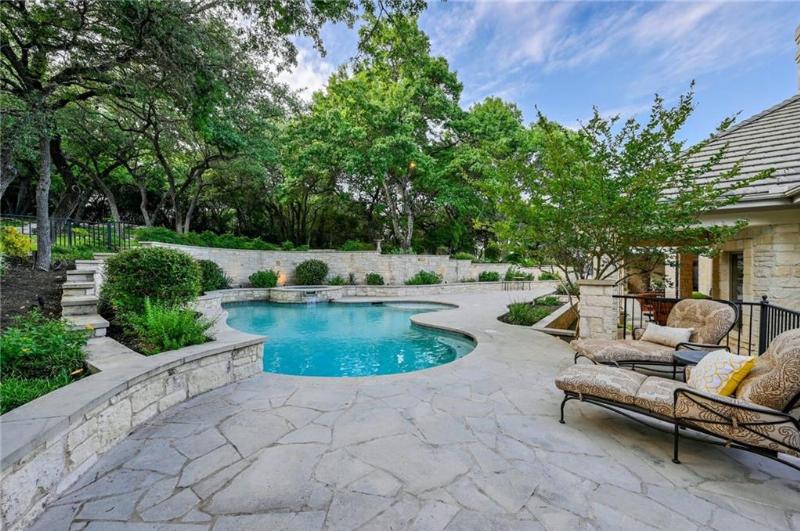Backyard Concrete Patio With Retaining Wall
Backyard concrete patio with retaining walls are renowned for their durability and adaptability which calls for accurate building techniques. The purpose of retaining walls is to retain. These barriers are designed to retain soil, stop erosion, or level out the ground’s slope and gradient. Retaining walls are excellent for a building’s aesthetic appeal, whether it is commercial or residential.
The functions of concrete retaining walls are essentially the same whether they are large or small, such as a large wall on a highway or a little wall enclosing a backyard garden.
What is a Retaining Wall?
A retaining wall is a structure that is intended and built to withstand soil pressure. It is built when there is a desired change in ground elevation that is greater than the angle of repose of the soil.
The soil is supported laterally by retaining walls so that it can be held at various levels on the two sides. The purpose of retaining walls is to hold soil to a slope that it would not naturally follow. It is usually used on a steep, near-vertical, or vertical slope.
Uses of Retaining Wall
There are several uses for retaining walls. Homeowners use it in the backyard as a barrier that can stop soil erosion. It can help a landscape’s drainage problems as well. In certain cases, retaining walls are erected just for decorative purposes in a landscape. They are also used when making a dam.
Pros of Retaining Wall
Strength
Concrete is incredibly strong and impenetrable which is important when it comes to supporting heavy loads of soil and water. Your concrete retaining wall will continue to harden in place after the installation, further boosting its strength.
Durability
A concrete retaining wall can bear a lot greater force and pressure when compared to other materials. It can also last for many years without a lot of maintenance.
ProTip Takeaway: In contrast to wood, which is less durable and more vulnerable to environmental deterioration, concrete is not only long-lasting but also resistant to elements such as fire, rust, and rot.
Increases property value
Your property might gain in value if a backyard patio with a retaining wall is erected and maintained properly. A retaining wall makes your house seem better from the outside while also protecting your property from erosion and water damage, which raises the value of your house overall.
ProTip Takeaway: Depending on the location and style of the retaining wall, property value gains will vary. A general rule of investment in this kind of landscaping will yield returns of between 100 and 200 %.
Easy to install. When compared to considerably more labor-intensive masonry constructions, installing a concrete retaining wall is typically quicker and simpler.
Flexibility. Curves, angles, or staircases can be easily integrated into the design of the retaining wall using concrete.
Cost. One of the most used and inexpensive building materials is concrete. Concrete blocks are quite cheap and your backyard patio with a retaining wall will last a very long time, making them an excellent investment.
Cons of Retaining Wall
Require complex designs. The backyard patio with the retaining wall needs to be carefully planned. It needs to be built with strong support and enough drainage. It cannot be done as a DIY design project.
Complex installation. It requires concrete casting and pouring which are also not do-it-yourself projects. Hire a skilled contractor with the knowledge to prevent bulging or cracking, which tend to weaken a structure over time and require intricate expensive repairs. (New Life Rockeries, 2020)
Backyard Concrete Patio With Retaining Wall Cost
|
Cost |
|
|---|---|
|
Concrete patio labor cost |
$2,532 |
|
The average cost of a concrete patio |
$1,533 and $4,740 |
|
Cost per square foot |
$4.40 and $16 |
|
Retaining wall cost per square foot |
$20 and $50 |
|
Retaining wall cost per linear foot for a simple wall |
$40 and $300 |
|
Retaining wall labor per square foot |
$10 to $30 |
|
Retaining wall material expenses per square foot |
$5 to $20 |
You can expect to pay $2,532 for labor and materials for a concrete patio. The average cost of a concrete patio is between $1,533 and $4,740, or $4.40 and $16 per square foot.
Prices for materials and labor make up the overall cost of installing a backyard patio with a retaining wall. You should budget between $20 and $50 per square foot or $40 and $300 per linear foot for a simple wall. The price will increase if you include a decorative finish, curves, steps, lighting, or other enhancements.
A 50′ long retaining wall typically costs $4,000 to $10,000 to install. Labor for retaining walls is from $10 to $30 per square foot, while material expenses typically range from $5 to $20 per square foot. Depending on the material and construction method, a concrete retaining wall installs for $20 to $45 per square foot. (Home Guide, 2021)
Building Backyard Concrete Patio with Retaining Wall
Do the following things before beginning to construct a backyard concrete patio with a retaining wall:
- Make sure you confirm the building codes with your local municipality before you begin work.
- Make sure you speak to a qualified engineer.
- Make sure you take into account soil erosion, water management, and nearby structures.
- After considering each of them, you can start to construct a backyard concrete patio with a retaining wall. (Concrete Network, 2020)
First, think about the foundation
One of the most important early choices is where to build the foundation so be sure to pick your foundation’s site wisely. The foundation of a backyard concrete patio with a retaining wall determines how sturdy it will be.
A competent engineer should evaluate the soil beneath the foundation to see if it can support the patio and retaining wall.
Any nearby features or constructions, such as garages, should also be taken into account by the engineer.
If the patio is next to the house’s foundation, additional factors such as drainage, soil and erosion need to be taken into account.
Building the Backyard Concrete Patio With Retaining Wall
These are general steps for building a backyard concrete patio with a retaining wall. Typically, the patio floor would be filled in after the retaining wall has been built. The design should be given the go-ahead by a licensed engineer and certain steps might be reversed based on your design complexity.
Location and design
Stake out the area once you have the plans and have chosen the spot. If your design has curves, use rope, twine, or even a flexible garden hose. After that, the area must be excavated, making sure to get rid of all the vegetation in the area. Get professional advice before doing any digging in the area.
Dig a base trench
The base trench should be dug at the lowest point of the chosen space.
The measurements will depend on the size and shape of the patio while the depth will be determined by the height of the retaining wall.
Compaction will be required in the patio area and the base trench which can be done with a plate compactor. This stage is important since the compacted area will serve as the foundation for the patio and the wall.
A drainage system must be installed. Keep in mind how fundamental proper drainage from the patio and retaining walls is. (Heritage Block, 2019)
ProTip Takeaway: Use a drain pipe to prevent water pressure from building up behind the retaining wall.
Build the retaining wall
- Lay out and excavate the footings.
- Build the forms.
- Add rebar for reinforcement by placing rebar every 16” on the center.
- Pour the footings and wall. The footings should be poured separately if the wall exceeds 4 feet in height.
- Let the concrete cure.
- Add contraction joints for every 4-6 feet.
- Remove the forms and put them in the waterproofing and drainage system.
- Finish the surface of the wall you want.
Construction of the retaining wall usually takes around 20 hours per every 10 to 15 feet of the wall being built. This time changes depending on the terrain, the wall type, and your degree of competence.
Once the wall has been built, check the wall’s stability and give it a thorough inspection for any potential issues. Hire a qualified contractor to build the wall for you if you don’t feel confident doing it yourself.
ProTip Takeaway: To maintain the wall’s condition after construction is finished, it’s important to seal and fix cracks as they appear. It is important to use high-quality crack filler for your concrete wall because concrete can crack as it ages.
Build the concrete patio
It’s time to install your concrete patio flooring once the retaining walls of your raised patio have been installed to the right height.
- Lay the base you are going to pour your concrete on top of.
- Create a form for your concrete.
- Saw off the top of the new stakes with your handsaw to level the top of the stakes at surface level.
- Coat your forms with a release agent or vegetable oil.
- Mix and pour your concrete.
- Make the finishing touches.
- Let the concrete cure for about two to three days.
ProTip Takeaway: Your patio surface must have a slope. Remember that water and runoff must be able to drain away from the house foundation. For driveways, a usual slope of 2 % is recommended. Anyone using the patio will be balanced and comfortable while proper drainage will still be possible.
Are You Ready To Remodel Your Patio?
Building a retaining wall is a great method to raise the value, use, and appeal of your property. It can offer a variety of advantages, but it is important to consider all the expenses and risks before deciding.
Call Smart Remodeling LLC if you’ve decided it’s time to have a backyard concrete patio with a retaining wall built at your house. Our team of contractors and landscaping experts place a high priority on providing high-quality retaining wall installation and client satisfaction.









